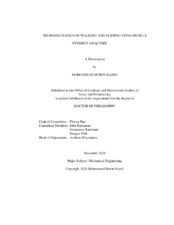| dc.description.abstract | Falls have numerous adverse effects on the economy and society. Slipping is the main contributor to falling. However, some individuals possess the ability to recover upon slipping while some do not. This dissertation studied the early indicators of falling in different individuals and compared them between mild slippers and severe slippers. The studied variables (sagittal angular moment (H), Center of Mass height, and the duration of single and double stance) all failed to show significant differences between the two severity groups before slip initiation, while the all differed after slip onset. H showed the earliest deviations among variables, indicating its importance in slip control. A muscle synergy (a united group of muscles that may act as a building block of the Central Nervous System in motor control) approach was chosen to study walking and slipping. Four synergies were identified for slipping, from which two were common between walking and slipping. Next, muscle synergies of slipping were compared for different severity groups. Severe slippers’ slipping synergies differed from mild slippers’, showing a probable difference in their motor control. Severe slippers were unable to replace their slipping limb as effectively. Upon finding post-slip differences, the walking behavior of mild and severe slippers were compared using muscle synergies. The walking muscle synergies also differed between mild and severe slippers, suggesting a difference in their gait control, causing their inclination to slip severely and fall. The results suggested severe slippers had a deficiency in decelerating their swing limb at the terminal swing phase of the gait and had higher dorsiflexion upon their heel strikes. Lastly, a muscle synergy approach was used to track the gait improvements of ADS patients upon surgical alignment. While their clinical gait variables showed improvements, they also required a higher number of synergies for walking, suggesting a more advanced gait control. Also, the entropy of muscle synergies were compared before and after surgery. Lower entropy is associated with more deterministic control. Upon the gait improvements, the entropy of the walking muscle synergies showed a significant decrease, proving it as a novel tool to track motor control enhancements in rehabilitation. | en |


